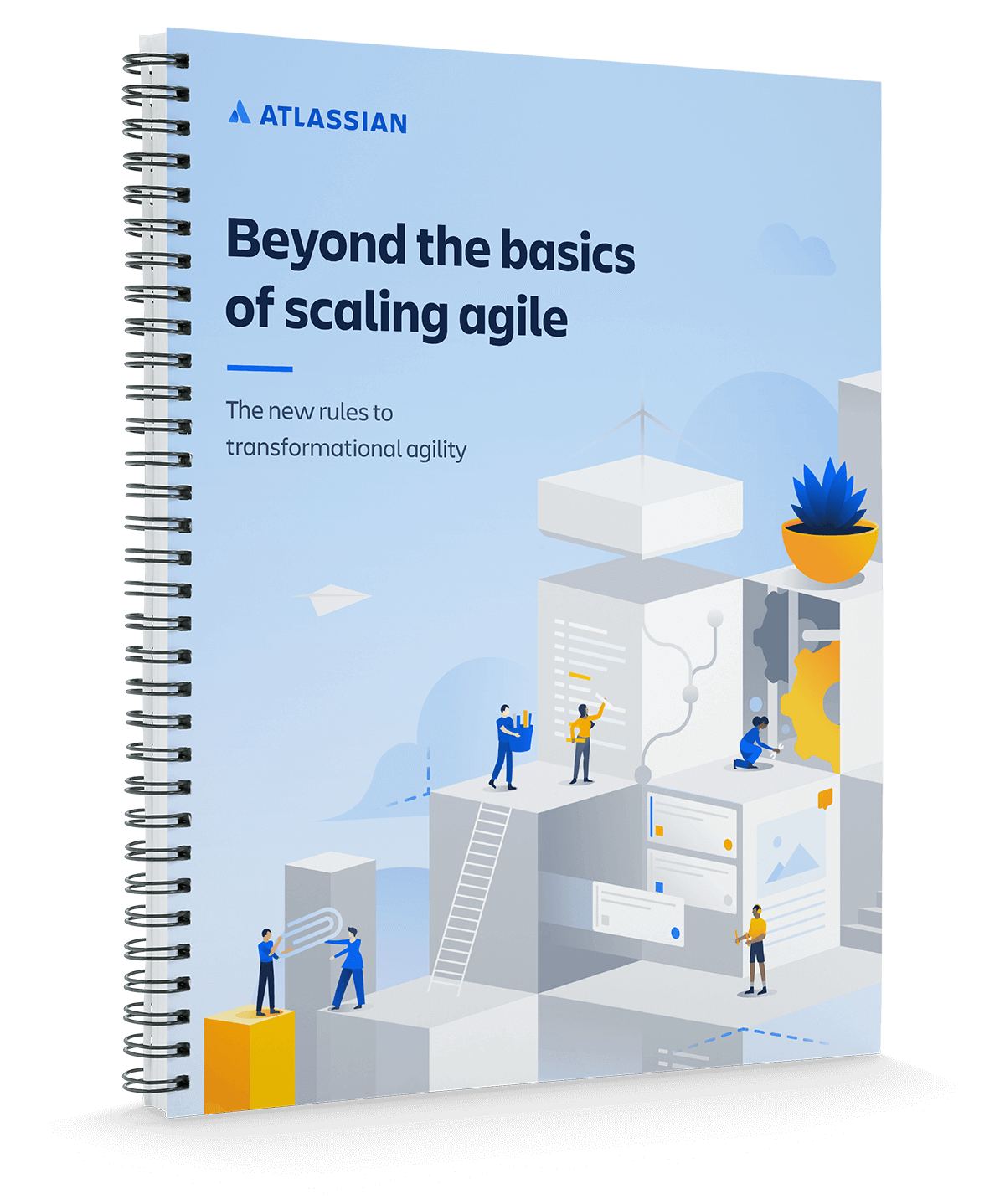Agile at scale
Movin' on up: scaling agile in large organizations
Browse topics
Software development teams have proven that implementing agile frameworks, like scrum and kanban, lets them deliver solutions to customers faster, with more predictability, and gives them the ability to react quickly based on new information. Implementing agile at the individual team level is relatively easy - the benefits are clear and the resources are plenty (like this very microsite!).
But the real challenge is extending it across multiple teams in a large organization. In other words, implementing agile at scale.
Agile at scale articles
Learn how to use epics in Jira
Use these step by step instructions to learn how to use and create epics in Jira.
Try this tutorialWhy are companies scaling agile?
Today, businesses need to be able to adapt, at enterprise scale, in order to stay competitive. The means to do so: responding to customers' evolving needs and delighting them in the process, providing flexible/customizable solutions, supporting teams of teams working on a unified front, shifting mindsets to place technology as a strategic enabler, and inspiring agile ways of working outside of software and IT teams.
But without a clear-cut plan or framework, it’s increasingly harder for companies that are scaling to predict delivery, manage cross-team dependencies, and focus on the right business objectives. As a result, this often leads to a decline in customer satisfaction, loss of market share or revenue, and more.
All of this is prompting companies to invest heavily in agile – to either capture the benefits of scaling agile frameworks that their software teams might have seen or to remain competitive in today’s market. But while large enterprises all might agree on the need for scaling agile frameworks, how to do it and what it looks like is a completely different discussion.
So, what is agile at scale?
Scaling agile frameworks is a cultural transformation, where the business’ people, practices, and tools are committed to improving collaboration and the organization’s ability to execute against its strategy.
Ultimately, changes across these areas will help decentralize decision-making, create greater transparency and alignment around work, and increase speed to market, all while hard coding the values of agile into the DNA of the organization.
Where are you on your agile at scale journey?
We like to chart how far along an organization is in its journey of scaling agile frameworks by looking at how teams and individuals are adopting agile practices.
Organizations at the beginning of their journey may only have pockets of people practicing agile, and work may be dominated by traditional project management procedures focused on managing a project from conception through to delivery.
Organizations that are further along may have scaled agile practices in play (or even the use of a framework). This may prompt cross-functional teams to organize in a way that improves efficiency, keeps them laser-focused on the value they deliver, and helps them navigate change by empowering them to make proactive decisions that help meet their business objectives.
No matter where you find yourself today, acknowledge and respect your position, and start from there.
Popular frameworks for scaling agile
There’s no right way to scale agile. But many organizations have had great success evolving their processes, teams, and cultures using frameworks for scaling agile.
Here’s a brief overview of the top agile scaling frameworks frameworks to explore:
SAFe
The Scaled Agile Framework® (SAFe®) is a set of organization and workflow patterns for implementing agile practices at enterprise scale. It was formed around three primary bodies of knowledge: agile software development, lean product development, and systems thinking. SAFe promotes alignment, collaboration, and delivery across large numbers of agile teams.
LeSS
Large-Scale Scrum (LeSS) is essentially regular scrum applied to large-scale development. LeSS is based on the idea that scaling frameworks should be minimalistic (i.e. include less rules, roles, and artifacts) to drive success. However, both LeSS and SAFe share some common patterns: Scrum at the team level, many teams sharing a backlog, collaborative planning across multiple teams, along with the general principles of pull and self-organization that any smaller agile team may be familiar with.
DA
Disciplined Agile (DA), previously referred to as Disciplined Agile Delivery (DAD), is a learning-oriented process decision framework for IT solution delivery. It provides a solid foundation from which to scale agile solution delivery within enterprise-class organizations. DA utilizes scrum and kanban, along with transformation knowledge in areas like HR and finance, governance, DevOps, portfolio management. and more. DA is often considered more flexible and easier to scale than other methods.
Spotify
Spotify’s approach wasn’t meant to be a framework per se, but the organization’s take on agile has organically emerged as one. The Spotify model is a people-driven, autonomous framework for scaling agile. It stresses the importance of culture and networks and provides an example for dealing with multiple teams in a product development organization.
Scrum@Scale (S@S)
Scrum@Scale is an extension of the scrum framework. Scrum@Scale is generally adopted by organizations that have already implemented scrum successfully at the team level and are looking to spread it throughout the organization. The main goal is to align growing organizations around one common and shared set of goals. Coordination is managed through a Scrum of Scrums, which is comprised of Scrum Masters from each team, and a MetaScrum made up of product owners.
Understanding the difference between agile scaling frameworks
Scaling agile frameworks can add unnecessary processes when they’re applied without thought or intent. But codifying shared rituals, common roles, and guiding principles for scaling agile in your organization has clear benefits, especially when the organization is new to agile ways of working. Here’s a helpful resource to guide your understanding of how each framework applies in these key areas.
| | SAFe (Scaled Agile Framework) | LeSS (Large Scale Scrum) & LeSS Huge | Spotify | DA | Scrum@Scale |
|---|---|---|---|---|---|
| Long term planning and strategy | SAFe (Scaled Agile Framework)
| LeSS (Large Scale Scrum) & LeSS Huge
| Spotify
| DA
| Scrum@Scale
|
| Multi agile teams | SAFe (Scaled Agile Framework)
| LeSS (Large Scale Scrum) & LeSS Huge
| Spotify
| DA
| Scrum@Scale
|
| Team of Teams | SAFe (Scaled Agile Framework) Agile Release Train (ART) | LeSS (Large Scale Scrum) & LeSS Huge Area | Spotify Tribes | DA
| Scrum@Scale Scrum of Scrums |
| PM/PO | SAFe (Scaled Agile Framework)
| LeSS (Large Scale Scrum) & LeSS Huge
| Spotify
| DA
| Scrum@Scale
|
| Scrum Master / Agile Coach | SAFe (Scaled Agile Framework)
| LeSS (Large Scale Scrum) & LeSS Huge
| Spotify
| DA
| Scrum@Scale
|
| Release Engineer / Group Manager | SAFe (Scaled Agile Framework)
| LeSS (Large Scale Scrum) & LeSS Huge
| Spotify
| DA
| Scrum@Scale
|
| Agile practice (scrum, kanban, etc.) | SAFe (Scaled Agile Framework)
| LeSS (Large Scale Scrum) & LeSS Huge
| Spotify
| DA
| Scrum@Scale
|
| Demo | SAFe (Scaled Agile Framework)
| LeSS (Large Scale Scrum) & LeSS Huge
| Spotify
| DA
| Scrum@Scale
|
| Retros | SAFe (Scaled Agile Framework)
| LeSS (Large Scale Scrum) & LeSS Huge
| Spotify
| DA
| Scrum@Scale
|
| Customer driven / value focused | SAFe (Scaled Agile Framework)
| LeSS (Large Scale Scrum) & LeSS Huge
| Spotify
| DA
| Scrum@Scale
|
| Dependency management | SAFe (Scaled Agile Framework)
| LeSS (Large Scale Scrum) & LeSS Huge
| Spotify
| DA
| Scrum@Scale
|
| Strategy transparency | SAFe (Scaled Agile Framework)
| LeSS (Large Scale Scrum) & LeSS Huge
| Spotify
| DA
| Scrum@Scale
|
| Portfolio management | SAFe (Scaled Agile Framework)
| LeSS (Large Scale Scrum) & LeSS Huge
| Spotify
| DA
| Scrum@Scale
|
| Release on demand | SAFe (Scaled Agile Framework)
| LeSS (Large Scale Scrum) & LeSS Huge
| Spotify
| DA
| Scrum@Scale
|
| Risk Management | SAFe (Scaled Agile Framework)
| LeSS (Large Scale Scrum) & LeSS Huge
| Spotify
| DA
| Scrum@Scale
|
| DevOps | SAFe (Scaled Agile Framework)
| LeSS (Large Scale Scrum) & LeSS Huge
| Spotify
| DA
| Scrum@Scale
|
Processes: Defined and prescribed Defined with recommendations Not clearly defined
As you can see, when examined closely, these agile scaling frameworks incorporate common organizational patterns involved in scaling agile. Regardless of whether or not you adopt a framework, we believe that by adopting some or all of these core patterns, you can reap many of the benefits of scaling agile in your organization.
7 essential principles for practicing agile at scale
While we acknowledge there isn’t any one-size-fits-all approach to scaling agile frameworks, there are seven essential principles for practicing agile at scale, which should be considered. These principles are “must-haves,” meaning, it'll be near impossible to be successful without them.
Regardless of whether you plan to use a framework or simply some practices, consider the below as guiding principles for what can be borrowed or formalized in your own organization.
- Defined roles and organizational structure changes
- Customer-centric organization and development
- Agile/scrum practices and cadence
- Adoption maturity (Take time to change)
- Dependency improvements
- Bottom-up & top-down buy-in (Actually change)
- People, Lean, and systems thinking
For more details on these principles and what they look like in practice, jump to our “Beyond the basics of scaling agile: the new rules to transformational agility” whitepaper below.
So, where to begin?
Scaling agile is not easy, and won’t happen overnight! Whether your organization goes all-in on a scaled agile framework, or implements a homegrown process, remember that “agile at scale” is not the end goal. The end goal is to effectively execute your strategy.
Keep trying new ideas and making incremental improvements with this aim in mind. And, don’t forget that the tools you use to support your business can play an important part in scaling agile.
A key component of agile is open and consistent communication. At Atlassian, we share projects and goal updates and discover what other teams are working on. By building a shared understanding of the context of work, we know what’s being worked on, why, who’s working on what, and the progress of work.
For a deeper dive into the topics we’ve covered on this page, check out our “Beyond the basics of scaling agile: the new rules to transformational agility” whitepaper. Packed full of helpful information and anecdotes from experienced agilists, it’s definitely worth a read.

Beyond the basics of scaling agile
Ensure your organization’s agile practices are built to last
Download our whitepaper to learn the new rules to transformational agility.
For more details on how Atlassian can support you on your agile journey, visit our agile at scale solutions page or compare the features of our agile at scale products.
Learn how to use epics in Jira
Use these step by step instructions to learn how to use and create epics in Jira.
Read this tutorialAgile Portfolio Management
Agile portfolio management helps large teams and developers efficiently manage projects. Read here to learn about high-functioning agile portfolios.
Read this article